Market Views: HDD Shipments Down 20% in Q1 2016, Hit Multi-Year Low
by Anton Shilov on May 12, 2016 8:00 AM ESTShipments of Client HDDs as a function of all Client Drives Drop
Long gone are the days when shipments of client HDDs by Seagate and Western Digital were around 75 million units per quarter. When PC sales drop to 60 – 66 million of units per quarter, it is simply impossible to sell that many drives. The two leading makers of HDDs supplied 45.7 million of hard disks in Q1 2016, down from 63.4 million from the same quarter last year. While Toshiba’s consumer drives should not be forgotten, it is evident that the increasing amount of new PCs use SSDs these days.
The SSD adoption rate in the notebook market in Q4 2015 was approximately 25~26%, according to TrendForce. In the first quarter that figure could easily go up because Seagate admitted that it did not want to play a part in certain areas of the low capacity notebook market. Moreover, as HDD platforms get more expensive in the coming years, hard drive makers may simply leave low-end bulk storage to SSD makers. In the end, it is relatively easy to build SSDs these days (it is not easy to manufacture NAND flash, of course), but HDD production involves a lot of R&D and state-of-the-art manufacturing facilities. As a result, companies like Seagate or Western Digital may simply lose interest in entry-level hard drives, especially given the fact that soon Western Digital will become a supplier of consumer SSDs as well.
As pointed out in the previous report, Seagate includes shipments of hard disk drives it sells for game consoles into its 2.5” client HDD category, whereas Western Digital includes its drives for consoles into its consumer electronics category. As a result, the picture is somewhat noisy here. Seagate sold 10.6 million 2.5” client HDDs in the first quarter, which is a drop of 37% from the same period a year ago. Since the company deliberately decided not to fight for low-end notebook deals, such a sharp decline is not something unexpected. Meanwhile, Western Digital supplied 13.6 million of its 2.5” client hard drives in Q1 2016, 28% less than in the same quarter last year.
Sales of client 3.5” HDDs by Seagate and Western Digital declined by 22.8% year-over-year, in line with the deterioration in the HDD market. Moreover, actual shipments of desktop hard disks were on the same level for the two leading makers: Seagate supplied 10.8 million units (a 24.5% drop YoY), whereas Western Digital shipped 10.7 million devices (a decrease of 21% YoY). We do not know how many 3.5” client hard drives Toshiba shipped in Q1, but it is safe to say that the market is on the decline in general and it does not make a lot of sense to fight for desktop market share these days.
In its recent conference call with investors and financial analysts, Seagate re-emphasized that it expected sales of its client drives to continue declining, but to keep gaining capacity. Historically, sales of Seagate’s client HDDs accounted for 60% of its revenue, whereas sales of enterprise products accounted for 40% of its revenue. Given the current market trends away from installing HDDs into tablets, 2-in-1 hybrid PCs or ultra-thin notebooks, client HDD revenue will eventually drop to 40% of Seagate’s revenue whereas enterprise hard drives will account for 60% of its revenue, the company revealed. With that said, it is expected that Seagate will focus on higher-capacity drives rather than on inexpensive devices that help to boost unit sales, as the latter is not something that is needed ion a weakening market.
Sales of External HDDs and NAS Fall
Because the number of PCs that cannot house more than one internal storage device is growing, external storage is getting some traction. Seagate and Western digital offer broad lineups of DAS and NAS devices under their own trademarks as well as under G-Technology and LaCie brands. While shipments of branded storage products do not drive huge volumes, this is a rather lucrative business for manufacturers offering higher ASPs.
Sales of branded DAS and NAS devices by Seagate and Western Digital totaled 10.357 million units in the first quarter of 2016, down 7.5% from 11.190 million units in Q1 2015. The two manufacturers sold an equal amount of external storage products: Seagate shipped 5.200 million branded devices (up 2% YoY), whereas Western Digital sold 5.157 million branded products (down 15.3% YoY). Historically, Western Digital outsold its main competitor with its My Cloud and My Passport external HDDs, but in the recent quarters Seagate has begun to catch up whereas sales of WD began to decline.
One thing that should be kept in mind when analyzing branded storage is that no matter how many HDDs are inside a DAS or a NAS, they are all considered as one unit (e.g., a WD My Book, a WD My Book Duo and a fully-populated My Cloud DL4100 are equal from accounting perspective). As a result, while we do see that unit sales of branded external storage by the two large makers have been slowly declining in the recent quarters, we do not know anything about the exact amount of drives inside as well as their storage capacities.
Consumer Electronics Still Consume A Lot of HDDs
The vast majority of consumer electronics (CE) devices nowadays use NAND flash memory. However, applications like set-top-boxes, DVRs, surveillance systems and game consoles remain sizeable consumers of hard drives, which is why makers of HDDs develop platforms specifically tailored for such devices.
Since shipments of Seagate’s CE HDDs do not include drives it supplies for game consoles (they are included in client 2.5” HDD sales), its CE business looks relatively stable and mostly driven by seasonality. In the first quarter of 2016, Seagate sold 5 million of CE HDDs, slightly up from 4.8 million supplied in the same period a year ago.
By contrast, Western Digital recognizes HGST Travelstar HDDs for Sony’s PlayStation 4 as consumer drives, which is why its CE numbers significantly depend on the production of PS4. Since in Q1 console sales and manufacturing are not on the rise, sales of Western Digital’s CE HDDs declined to 7.3 million units, down 15.2% from Q1 2015. The reasons for the drop are unclear - perhaps Sony decided to slow down PS4 production, or perhaps shipments of some other Western Digital products were not strong.
Anyway, due to account policies of the two leading makers of hard drives, it is impossible to compare their CE HDD businesses directly.


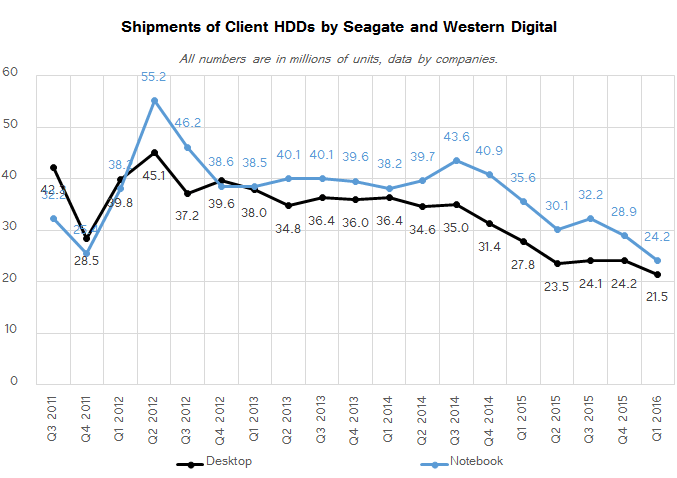
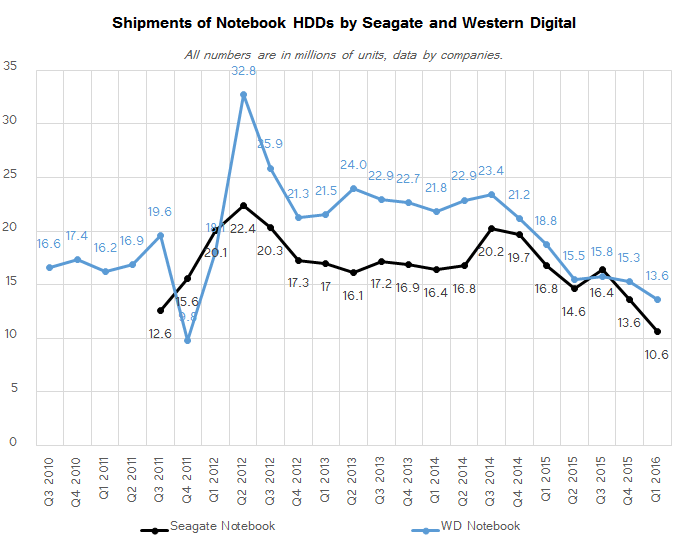
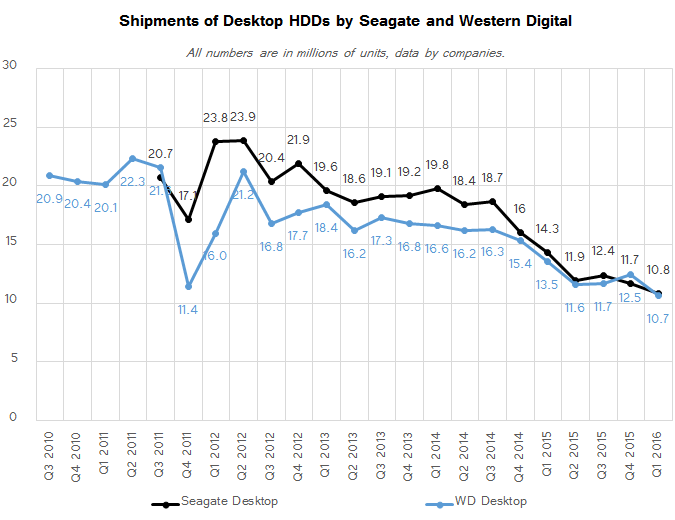
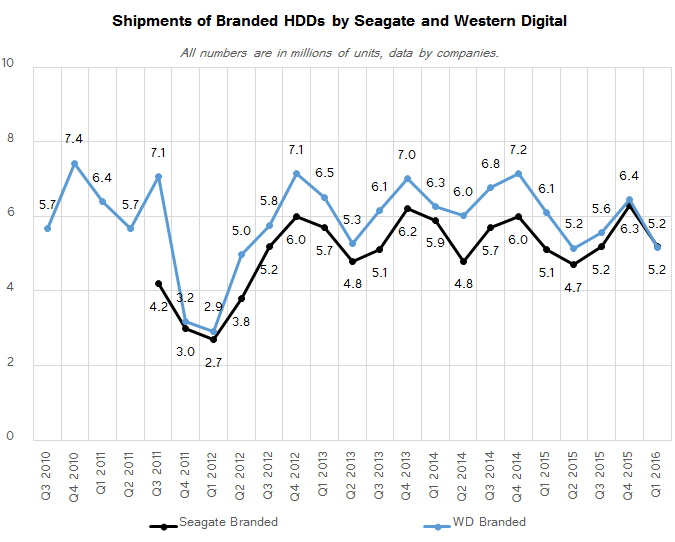
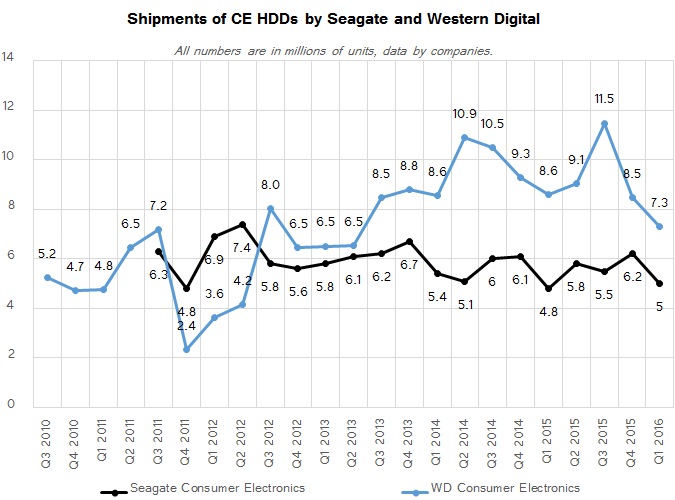








116 Comments
View All Comments
Wolfpup - Thursday, July 14, 2016 - link
No it isn't. 1TB is nothing if you're having to pull in this kind of data. Hell, a lot of new games are about 50GB a piece now.seerak - Monday, May 16, 2016 - link
Or screwups like this onehttp://www.snopes.com/apple-music-deleting-files/
Wolfpup - Thursday, July 14, 2016 - link
Yeah, Comcast is rolling their caps out wider starting NEXT MONTH. They're the largest ISP, so....will792 - Thursday, May 12, 2016 - link
I have numerous friends with rapidly growing repository of video and image files (NEF files for Nikon D800 are 30-35MB each). Hard drives are the only realistic option to store multi terabyte libraries of created content that is typically mirrored and backed up. Proliferation of video created with GoPro or other action video cameras (including drone mounted cameras) will force consumers to buy hard drives since upload speed of typical Internet connection is too slow for upload of high resolution video content.Murloc - Thursday, May 12, 2016 - link
at the end of the day, not a high % of people do that kind of stuff even though it's gotten more popular over the year.Just about everybody I know owns a laptop. If those increasingly come without HDDs but with SSDs, that's gone, RAW photographers or not.
DanNeely - Thursday, May 12, 2016 - link
In the medium term I wouldn't be concerned about disks for photography (or other bulk storage). The 3.5" HDDs best suited for USB drives/NASes are most similar to enterprise nearline storage drives; which as a segment dominated by cost/gb should be the most resilient part of the HDD market. Until/unless flash becomes cheaper per GB they're unlikely to go away.The short term situation of bottom end consumer drives being in freefall doesn't really matter beyond headline sales figures. The margin on those drives is near zero, so losing them doesn't affect the bottom line much (and that primarily from one time costs related to scaling down production capacity).
I wouldn't worry until sales for 10/15k SAS drives start plummeting as well. They have the highest margins and fund an out-sized share of the R&D needed to develop higher capacity drives. When that goes away we'll either see a significant slowdown in capacity growth or rise in prices to sustain R&D spending (or both). That will probably be the beginning of the end for HDDs by making it much easier for flash to catch up in price/GB.
tamalero - Tuesday, May 17, 2016 - link
arent 10k 15k sas drives being replaced by SSDs in the corporate level?FunBunny2 - Thursday, May 12, 2016 - link
yeah. what drove the first PC period was Word/Office at home, likely pirated from work. no one has ever had much need for more than 640K until the recent gaming fiasco. windoze bloated up, which drove it, too. but that has ended. we're now in the Times of Good Enough.Michael Bay - Thursday, May 12, 2016 - link
>gaming fiasco>windoze
Don`t forget to take your meds, please.
Wolfpup - Thursday, July 14, 2016 - link
<<< no one has ever had much need for more than 640K>>>(!) Uh... Are you in the right decade?
And what's a "gaming fiasco"?